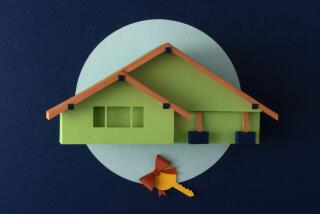Hard to satisfy buyers’ dreams
- Share via
The buyers have waited anxiously for months to move into their newly built house, which, in theory, has been constructed to their specifications. After all, isn’t that the reason most people build: to get a house just the way they want it so they can sit back and enjoy it?
Not necessarily. Surprisingly large numbers of them will set out almost immediately to change that house, spending thousands of dollars. And just about as many will begin thinking about what they want in the next a few years down the road.
These are the conclusions of a national survey of consumers who had bought new and existing homes in the last two years and households that had completed extensive remodeling.
The survey, produced by Builder magazine and the Joint Center for Housing Studies at Harvard University, found that most buyers say they’re satisfied with the overall product and experience but that the home building industry is far from the top of the satisfaction meter.
“One of our major findings is that customer service leaves a lot to be desired,” said magazine editor Boyce Thompson, who presented the findings of the Housing Continuum Survey at a recent home building industry conference in Chicago. Thompson said that researchers knew consumers’ post-construction satisfaction had been a thorny area, but they were surprised at some numbers.
For instance, among those in newly built homes, about 33% of first-time buyers and about 25% of repeat buyers said they were unhappy about the service they received after construction: the “callbacks” to fix imperfections that inevitably occur.
“This is not a good number in any industry,” Thompson said.
On the other hand, only about 10% of the buyers expressed overall dissatisfaction when asked to factor in their impressions of service in such categories as purchasing and contracting, construction, financing and general quality. Among the recent buyers surveyed, about 30% said they began their home search with a preference for new construction and 30% had preferred a resale.
“There’s a big group in the middle that could go either way, and it’s in the builders’ interest to scrutinize how that middle was swayed,” said Sal Alfano, editor of Builder’s sister publication, Remodeling, a trade journal that participated in the research.
The study concluded that, at the simplest level, the attraction of “new” is the promise of minimal maintenance and the attraction of a resale is “location.”
The largest group of new-house buyers, 27%, said maintenance was the main factor. Other reasons, in descending order, were that they thought a new house would be less expensive, that the design would be exactly what they wanted and that they didn’t want a fixer-upper. Only 12% said they picked new because the quality would be better than that of a resale.
And the location question for many resale buyers apparently translates into a desire for a “mature” neighborhood, according to the researchers, in terms trees and landscaping.
Kermit Baker, director of the Harvard housing group, said surprising findings were how much money buyers of brand-new houses spend on changing them and that a huge proportion of it was spent on landscaping.
“The average first-time buyer of a new home is spending $3,500 in two years,” Baker said, adding that about 41% spend $5,000 or more. About 56% of repeat buyers of new residences spend more than $5,000 in the first two years.
“About $4 billion to $5 billion per year is spent by buyers of new homes on home improvements,” Baker said.
According to the study, 84% of new-home buyers put money into landscaping and 65% installed decks or patios.
Other frequent projects involved replacing the new light fixtures (59%), changing the flooring in one or more rooms (41%) and replacing window treatments (53%). Eighty percent said they repainted at least one room within two years of moving in.
The study also concluded that all buyers, whether they purchased a new or older home, seemed to be constantly thinking about what they would buy next. This is a reflection less of dissatisfaction than of real estate wanderlust, Thompson said.
According to the survey, 11% of first-time buyers of new residences and 25% of repeat buyers considered their purchases to be a “dream house” in which they would reside forevermore.
Across all categories of buyers, one-third to one-half said they were happy with their homes “for now” but intended to move soon. Among first-time buyers of both kinds of housing, about one-third expected to move within three years. Almost another third thought they would be gone in five years.
More to Read
Inside the business of entertainment
The Wide Shot brings you news, analysis and insights on everything from streaming wars to production — and what it all means for the future.
You may occasionally receive promotional content from the Los Angeles Times.










